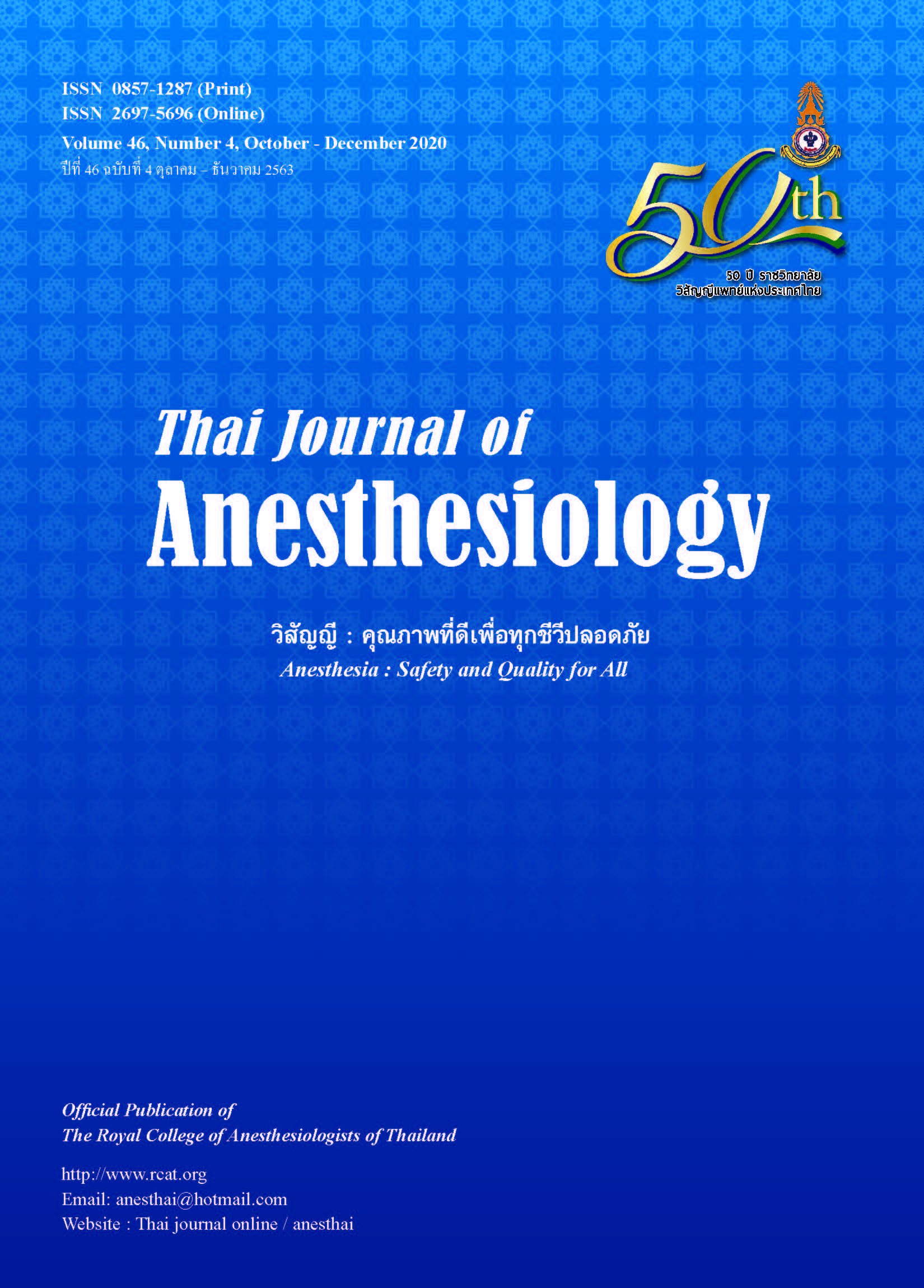Ultrasound Assessment of Gastric Contents and Volume in Emergency Surgery Patients
Main Article Content
Abstract
Introduction: Emergency surgery patients have a risk of full stomach that is an important factor of perioperative pulmonary aspiration. The aim of this study are to assess gastric content and volume in emergency surgery patients by using scanning protocol of ultrasound, determine the prevalence and risk factors associated with full stomach. Methods: This study was a prospective descriptive study. One hundred and fifty patients who were going to have emergency operation were assessed gastric content and volume by using ultrasound in supine and right lateral decubitus position. Results: There were 70 patients (46.6%) with full stomach. Solid contents were found in 63 patients. Clear fluid content volume more than 1.5 ml/kg were found in 7 patients. The risk factor of full stomach was severe pain (Odds Ratios =5.12, 95% CI = 1.61, 16.22). There were not statistically different of ultrasound assessment time between emptying stomach group and full stomach group and the procedure time was less than 1 minute. The result of gastric assessment affected anesthetic management in 11 patients (7.33%). Conclusion: Gastric assessment by using ultrasound can identify a full stomach condition in emergency patients and not take time to do this procedure. The result of gastric assessment can help for anesthetic planning
Article Details
References
IA. The incidence and outcome of perioperative pulmonary
aspiration in a university hospital: a 4-year retrospective
analysis. Anesth Analg 2006;103:941-7.
2. Cook TM, Woodall N, Frerk C. Fourth National Audit Project.
Major complications of airway management in UK: results of
the Fourth National Audit Project of the Royal College of
Anaesthetists and the Difficult Airway Society. Part1:
Anesthesia. Br J Anaesth 2011;106:617-31.
3. Neilipovitz DT, Crosby ET. No evidence for decreased
incidence of aspiration after rapid sequence induction. Can
J Anaesth 2007;54:748-64.
4. Ng A, Smith G. Gastroesophageal reflux and aspiration of
gastric contents in anesthetic practice. Anesth Analg
2001;93:494-513.
5. Borland LM, Sereika SM, Woelfel SK, et al. Pulmonary
aspiration in pediatric patients during general anesthesia:
incidence and outcome. J Clin Anesth 1998;10:95-102.
6. Kozlow JH, Berenholtz SM, Garrett E, Dorman T, Pronovost
PJ. Epidemiology and impact of aspiration pneumonia in
patients undergoing surgery in Maryland, 1999-2000. Crit
Care Med 2003;31:1930-7.
7. Charuluxananan S, Sriraj W, Punjasawadwong Y, et al.
Perioperative and Anesthetic Adverse events in Thailand
(PAAd Thai) incident reporting study: anesthetic profiles and
outcomes. Asian Biomedicine 2017;11:21-32.
8. American Society of Anaesthesiologists Committee. Practice
guidelines for preoperative fasting and the use of
pharmacologic agents to reduce the risk of pulmonary
aspiration: application to healthy patients undergoing
elective procedures. Anesthesiology 2017;126:376-93.
9. Van de Putte P, Vernieuwe L, Jerjir A, Verschueren L,
Tacken M, Perlas A. When fasted is not empty: a retrospective
cohort study of gastric content in fasted surgical patients.
Br J Anaesth 2017; 118:363-71.
10. Bouvet L, Desgranges FP, Aubergy C, et al. Prevalence and
factors predictive of full stomach in elective and emergency
surgical patients: a prospective cohort study. Br J Anaesth
2017;118 :372-9
11. Kruisselbrink R, Gharapetian A, Chaparro LE, et al.
Diagnostic accuracy of point-of-care gastric ultrasound.
Anesth Analg 2019;128:89-95.
12. Perlas A, Mitsakakis N, Liu L, et al. Validation of a
mathematical model for ultrasound assessment of gastric
volume by gastroscopic examination. Anesth Analg
2013;116: 357-63.
13. Van de Putte P, Perlas A. Ultrasound assessment of gastric
content and volume. Br J Anaesth 2014;113:12-22.
14. Kruisselbrink R, Arzola C, Endersby R, Tse C, Chan V, Perlas
A. Intra-and interrater reliability of ultrasound assessment of
gastric volume. Anesthesiology 2014;121: 46-51.
15. Kruisselbrink R, Arzola C, Jackson T, Okrainec A, Chan V,
Perlas A. Ultrasound assessment of gastric volume in
severely obese individuals: a validation study. Br J Anaesth
2017;118:77-82.

